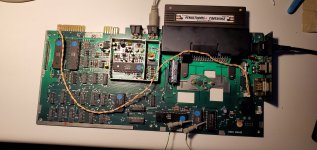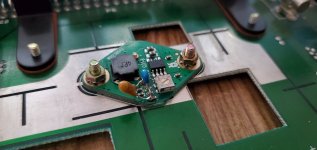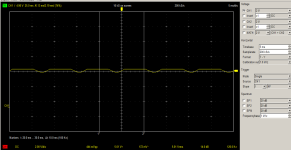Divarin
Veteran Member
I posted this earlier and have been trying to resolve this issue.
The symptoms I'm noticing (Wavy video and hum in audio) is described here as being either the fault of the bridge rectifier or the voltage regulator.
Hooking up the computer to the oscilloscope the output of the bridge rectifier is a flat voltage yet the output of the voltage regulator and also the 5 volt pin on the user port has a wave in it at (what my scope is reporting) 120 hz (see image below).
According to the link above at retroisle.com the regulator is an LM323K however looking at the schematic at zimmers.net (I'm going by the three tiffs near the bottom, for voltage regulation specifically: "vic20-left.tiff") the voltage regulator is an SI-3554M. And then there's what's actually in this system which is neither: SH323SC.
Of course in typical Commodore fashion they probably just used whatever they had or maybe someone had replaced it at some point.
I have found a modern replacement for the LM323K which looks like a buck converter in a form factor that would serve as a drop-in replacement for this part.
Before I go that route though I thought I'd see if someone more knowledgeable with electronics might have some input. First I haven't entirely ruled out the bridge rectifier. Although the diodes seem to be working (voltage is only travelling in one direction) the output seems low, I would expect 9 volts DC but I'm only getting a little above 5. Yesterday when I tested it I was getting around 7 volts output so maybe the bridge rectifier is flaky and not providing enough voltage for the regulator to do its thing.
For reference here is what I'm seeing on the 5 volt line measured at the user port:

The symptoms I'm noticing (Wavy video and hum in audio) is described here as being either the fault of the bridge rectifier or the voltage regulator.
Hooking up the computer to the oscilloscope the output of the bridge rectifier is a flat voltage yet the output of the voltage regulator and also the 5 volt pin on the user port has a wave in it at (what my scope is reporting) 120 hz (see image below).
According to the link above at retroisle.com the regulator is an LM323K however looking at the schematic at zimmers.net (I'm going by the three tiffs near the bottom, for voltage regulation specifically: "vic20-left.tiff") the voltage regulator is an SI-3554M. And then there's what's actually in this system which is neither: SH323SC.
Of course in typical Commodore fashion they probably just used whatever they had or maybe someone had replaced it at some point.
I have found a modern replacement for the LM323K which looks like a buck converter in a form factor that would serve as a drop-in replacement for this part.
Before I go that route though I thought I'd see if someone more knowledgeable with electronics might have some input. First I haven't entirely ruled out the bridge rectifier. Although the diodes seem to be working (voltage is only travelling in one direction) the output seems low, I would expect 9 volts DC but I'm only getting a little above 5. Yesterday when I tested it I was getting around 7 volts output so maybe the bridge rectifier is flaky and not providing enough voltage for the regulator to do its thing.
For reference here is what I'm seeing on the 5 volt line measured at the user port:




